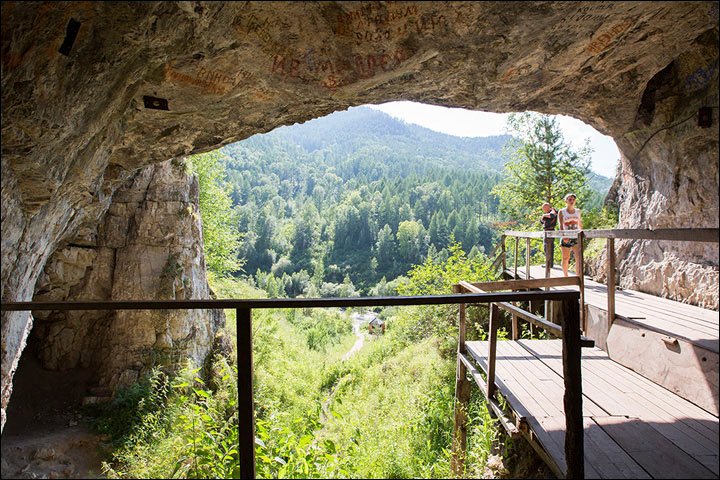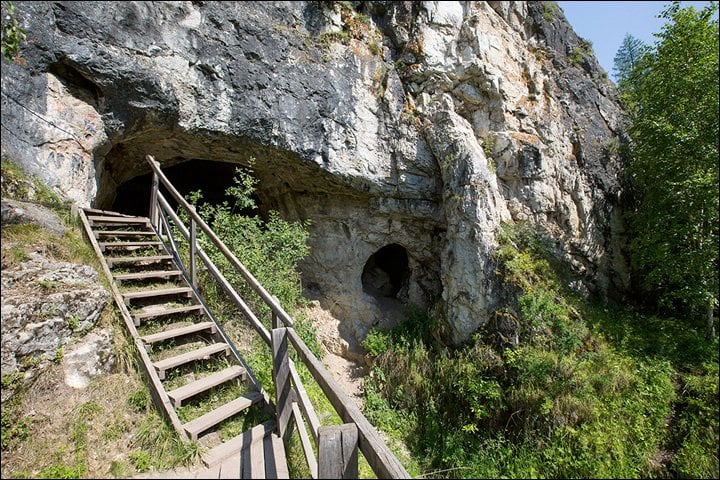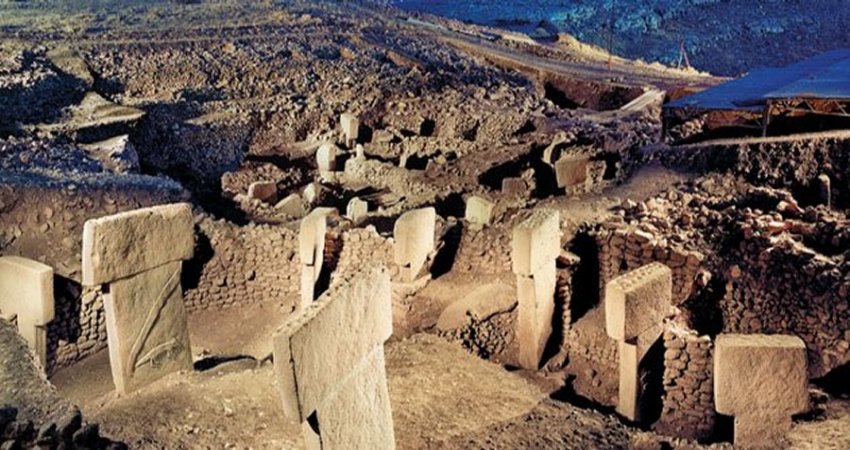First Unique View Inside The Denisova Cave And It’s Ancient History
MessageToEagle.com – These exclusive pictures show the world famous Denisova Cave in the Altai Mountains from which a series of stunning scientific discoveries on man’s origins have been made in recent years.
More are expected as a result of a hive of archeological activity – overseen by the specialists from Novosibirsk State University – underway at this unique site inhabited continuously from the deep past.

Scientist Maksim Kozlikin said: ‘We are working with Oxford University in the UK, they help us with radiocarbon and other dating and also conduct studies of ancient DNA. Currently, we continue cooperation and there can be new joint scientific articles.’

The significance of the cave is immense, and the experts are convinced it has more secrets to give up on human origins. Here in 2008 was discovered a finger bone fragment of ‘X woman’, a juvenile female who lived around 41,000 years ago, analysis of which indicated that she was genetically distinct from Neanderthals and modern humans.
This previously unknown and long extinct hominin species or subspecies was christened Denisovan after this cave. In 2010 analysis on an upper molar from a young adult, found in the cave ten years previously, was also from a Denisovan.
In 2011, a toe bone contemporary with the finger was found with the mitochondrial DNA suggesting it belonged to a Neanderthal, not a Denisovan. Tools from modern man have been found in the cave, too.
As scientist Svante Paabo, from the Max Planck Institute for Evolutionary Anthropology in Leipzig, Germany, said: ‘The one place where we are sure all three human forms have lived at one time or another is here in Denisova Cave.’
Another significant find in 2008 – in the same layer as the Denisovan bone – was a stone bracelet dated 40,000 years old, but it was made using the technologies specific to a much later time.
It was due to this cave that scientists understood the settlement of this part of Siberia went back longer than the assumed 30,000 to 50,000 years. Traces in the ‘cultural layer’ of the Denisova show the human habitat reaching back 282,000 years. So far it has given up more than 80 000 exhibits including implements, arms, ornaments, and the remains of animals and plants.
The Denisova Cave is located in the Bashelaksky Range of the north-western Altai Mountains, close to the border of today’s Altai Region and the Altai Republic, but in ancient times it would have been an attractive location.
The cave is at an altitude of 670 meters above sea level, and at 28 meters above the present level of the Anui River.
Kozlikin, a research fellow of Institute of Archaeology and Ethnography, part of the the Siberian Branch of the Russian Academy of Sciences, explained: ‘From the ancient hunter’s point of view the location of Denisova Cave was very convenient. To the north of the cave stretches a rather wide valley, and there is another to the south.
‘At this very place, where the cave is located, is in fact a canyon, because the width of the bottom of the valley here is less than the distance between two major peaks – Mount Karakol and Mount Sosnovaya. So Denisova Cave is in a rather narrow canyon. Through this canyon – as if through a bottle neck – migrated the animals, from one valley to another. So the ancient hunter always had enough prey. There is a water nearby and good climatic conditions of the mountainous valleys.’

In the late Pleistocene era, some 100,000 years ago, an ice sheet covered much of western Siberia, but not Altai valleys such as this. ‘So it was a good place for hunting and gathering plants too, and very comfortable conditions for the humans and animals.’
Indeed, there are other signs this was a hive of activity in ancient times.
A few kilometres down the Anui River is located Paleolithic site Anui-2 and four kilometres up the river is Karakol site and others, so there are quite a lot of Paleolithic sites on this area, around the cave.
‘During the excavations, we found that the most ancient – 22nd – layer of Denisova Cave is ‘sterile’, in other words, there are no remains, or sediments.
‘It turned out that 300,000 years ago Anui River had another bed, which was located higher, very close to the entrance of the cave. As soon as its course became lower, ancient humans and animals begin to visit the cave. On the upper part of the 22nd layer were found implements and the remains of animals. This happened around 282,000 years ago.
‘At this time, the climate here was rather mild. Oak grew here, along with hornbeam, Manchurian walnut and even the northern species of bamboo. We see here the remains of European ass, bison, woolly rhino, several species of deer, elk, cave lion, cave hyena, bear, and snow leopard.

‘Before the excavations, there was only a rather narrow manhole to the cave, because sediments covered it. The width of a manhole was about 1.4 metres. The cave was known to locals and some even left the inscriptions at the entrance at the beginning of the 20th century. Still they did not venture further in simply because there was not so much space inside.
In 1977 famous paleontologist Nikolay Ovodov made a pit in the central part of the cave and found a lot of paleontological material and stone implements. He shared with his findings with archaeologists and in 1978 Alexey Okladnikov came here.
‘Since 1984, archaeological expeditions work here every summer. In late 1980s and early 1990 here was built a permanent archaeological camp – houses and other facilities. So for more than 30 years there have been archaeological works are conducted here. Still the huge part of the cave is not explored yet, even the central hall.’
Work can go on here for many years, with the prospect of major new discoveries.
Giving us a tour of the cave, Kozlikin said: ‘On the right the central hall adjoins the southern gallery, which is about 20 metres wide and it is almost fully covered with unexplored sediment. Now the work is being done in the eastern gallery, next to the central hall.
‘In this eastern gallery we have already finished the famous 11th layer, which brought us the Denisovan’s finger bone, bracelet and a necklace of elk teeth. Now we went deeper and are working with the 12th, 13th, and 14th layer – Middle Paleolithic. The 14th layer is dated about 180,000 years ago. Here we have typical Middle Paleolithic stone implements.’
He explained the way the inside of the cave is divided for the digs to ensure that no precious material is lost, and all clues are understood.
‘We divided the area into squares with the size 1×1 metre. Each square we subdivided into two parts. Over there you see that these girls sitting and carefully removing all the ground from the square, layer by layer. Each thin layer is about 4 cm.
‘If they see any big find – implements or bones, they leave it in its place, and carefully clean it. We make pictures, draw the location and measure the angle to understand if the find was replaced or moved.
If it lies at an angle to the surface, we suggest that the find and the layer was somehow disturbed. If the finding lies horizontally, we see that the layer was not disturbed. All the measurement we put on excavation site plan, with the exact coordinates. Here no more than two can work. Even for such slim girls there is not so much space here.
‘All the ground they put into a bucket together with the label, which indicates the number of the layer and the square. These layers are sent using a special device down to the bank of the Anui River.’
The buckets are send from the cave to the river via the specially designed ‘Cableroad’ using a device called a Pepelats, initially designed to work at the archaeological site Ust-Karakol-1 by Dr Alexander Postnov. It allows up to nine full buckets to be carried to the opposite river bank 28 metres below the cave.
‘On the riverbank we have the ‘washing point.’ The ground from the buckets is put into the sieves with a different mesh size, so we can divide the big fragments from the small ones,’ he said.
Andrey Chekha, junior researcher at the Institute of Archaeology and Ethnography, said big and small fragments are separated. ‘From the big fragments, we choose the implements and bones, then clean them once again and mark with the number of layer, square, and year.’
With the small particles ‘the girls sit with tweezers picking the tiny details, including the teeth of rodents, which allow us to determine the climate at that time.’
Maksim Kozlikin added: ‘For one season, which usually lasts from early June to late August, we dig out not more than three cubic meters of ground. You can see that we are moving very slowly, but this is what allows us to make such a good finds.
‘We try not to lose any tiny part. For example, the finger bone of Denisovan girl – it is a very small bone, but we managed to spot it. Also, in our ‘jewellery collection’ we have beads made of fossilised shells of ostrich eggs. They do not exceed 0.5 cm in diameter. There is a lot of work here. We have almost finished with the famous 11th layer in the central hall and eastern gallery, but it is almost intact in the southern gallery.

‘Still, we will finish the eastern gallery and only then will move to the southern. Of course, we are looking forward to new sensational finds related to the Denisovans in 11th layer in the southern gallery, but we cannot just switch from one part of the cave to another, we must work sequentially. Besides, we hope to have interesting finding in the 12th, 13th and 14th layers.
‘The cave has an interesting peculiarity, namely that the bones here preserve very well. Because of this, we managed to get the mitochondria DNA from the finger bone dating back 40,000 years. We hope to have good finds in more ancient layers too.’
MessageToEagle.com














